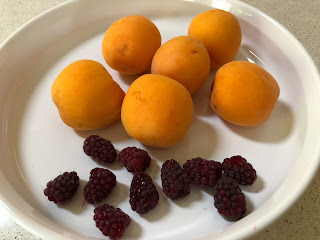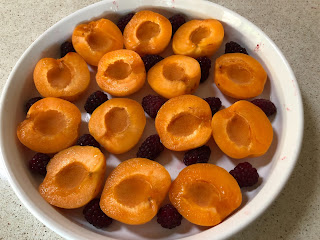
Recipe: Showcase apricots and berries in an easy dessert
 |
| Apricots and loganberries are baked in an eggy batter for clafoutis. (Photos: Kathy Morrison) |
Apricots have such a short season locally that you have to move fast if you want to bake with them.
Apricot pie is a natural, of course, but I've learned something about that over the years: Apricot pie tastes best if you peel the apricots first. Otherwise, a slight bitterness lingers.
If you're not up to peeling apricots, and I don't blame you, instead bake a clafoutis, a wonderful fruit-centric dessert that lands somewhere between custard and cake. The bitterness isn't concentrated here, and you don't need nearly as many precious apricots.

I wound up using one more apricot and about eight more berries |
The clafoutis' culinary ancestry is in France, where it traditionally is made with whole, unpitted cherries. (Gotta warn people when you do that.)
But really any fresh fruit can go into a clafoutis. The key is a wide, flat tart pan (a large pie pan also works) and room-temperature eggs and milk. Pour the batter around the fruit and pop it in the oven for a dessert that also works as a brunch dish. You can even eat it cold, in the unlikely event there are leftovers.
This particular version was determined by the fruit available at the Saturday farmers market. One vendor, from Apple Hill, had loganberries and tayberries along with his gorgeous blueberries. I bought some of the loganberries (a cross between blackberries and raspberries) to add color to the clafoutis. The other berries would have worked, too. Cherries also play well with apricots, though I prefer to pit them.
The recipe is adapted from several sources, including three versions on the New York Times Cooking site.

The fruit's ready for the batter to be added. I poured it in
from the side to prevent disturbing my fruit pattern
|
Apricot and loganberry clafoutis
Serves 4 to 6
Ingredients:
Butter for pan
6 to 7 fresh apricots (about 1 pound)
1/2 cup (or more) fresh berries
1 1/4 cups whole milk, room temperature
3 eggs, room temperature
1 teaspoon vanilla extract
1/3 cup all-purpose flour
1/3 cup almond flour
6 tablespoons granulated sugar
Pinch sea salt
Instructions:
Preheat oven to 375 degrees. Butter a 10-inch ceramic tart pan or pie plate. (A deep 9-inch pan will work, but the clafoutis may take longer to bake.)
Halve and pit the apricots, and lay them cut side up in one layer in the prepared pan. You may need one more apricot or one fewer, depending on the size of the pan. Distribute the berries evenly among the apricot halves. Set pan aside while you make the batter.
Beat the milk and the eggs together in a bowl or large measuring cup, then blend in the vanilla extract. Whisk in the flours, then the sugar and salt, until thoroughly blended.
Pour the batter into the pan around the fruit. Carefully transfer the pan to the oven. Bake 35 to 40 minutes until the clafoutis is light golden brown and puffed. Remove to a rack and let cool 10 minutes before cutting and serving. (Clafoutis may deflate just a bit during cooling.) Or allow to cool completely before serving.
Comments
0 comments have been posted.Sacramento Digs Gardening to your inbox.
Sites We Like
Garden Checklist for week of July 21
Your garden needs you!
* Keep your vegetable garden watered, mulched and weeded. Water before 8 a.m. to reduce the chance of fungal infection and to conserve moisture.
* Feed vegetable plants bone meal, rock phosphate or other fertilizers high in phosphate to stimulate more blooms and fruiting. (But wait until daily high temperatures drop out of the 100s.)
* Don’t let tomatoes wilt or dry out completely. Give tomatoes a deep watering two to three times a week.
* Harvest vegetables promptly to encourage plants to produce more. Squash especially tends to grow rapidly in hot weather. Keep an eye on zucchini.
* Pinch back chrysanthemums for bushy plants and more flowers in September.
* Remove spent flowers from roses, daylilies and other bloomers as they finish flowering.
* Pinch off blooms from basil so the plant will grow more leaves.
* Cut back lavender after flowering to promote a second bloom.
* It's not too late to add a splash of color. Plant petunias, snapdragons, zinnias and marigolds.
* From seed, plant corn, pumpkins, radishes, winter squash and sunflowers.